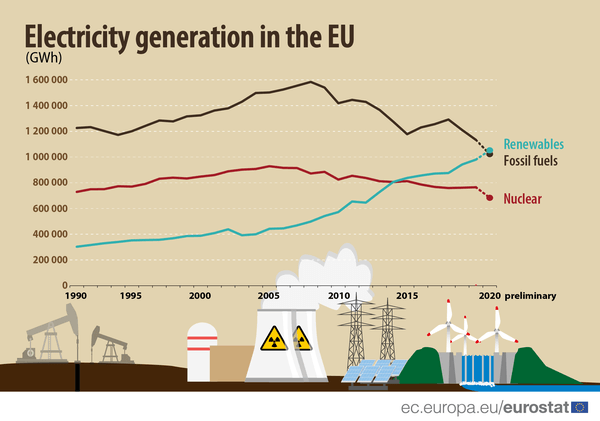News Release from windfair.net
Wind Industry Profile of
Renewable production picks up in Europe
The latest European Union statistics, issued by Eurostat, show that electricity consumption and production declined in Europe last year due to the widespread lockdowns. In particular, electricity production from fossil fuels such as coal, oil and natural gas suffered from the pandemic and continued its decline, which has been ongoing for some time. In 2020, fossils reached an interim low, with a 9.8 percent year-on-year decline.
Reference figure is that of 1990, when data were first collected. At that time, 1,226,156 gigawatt hours (GWh) of energy were produced from fossil sources. Production then peaked in 2007 at 1,584,005 GWh. However, this figure has been falling steadily for several years - from 1,133,402 GWh in 2019 to now 1,022,589 GWh in 2020.
Such a trend can also be observed in nuclear energy, where preliminary data for 2020 show the lowest level since 1990 at 683,183 GWh (6.3% less than in 1990). This is not surprising, as in recent years countries like Germany, Italy, Lithuania, Belgium and Switzerland have phased out nuclear power or have initiated the phase-out process. Although other European countries have announced further expansion of their nuclear power capacities, the cost of building a nuclear power plant has risen sharply in the meantime and is hardly worthwhile compared to other energy sources.

Electricity production in Europe is changing (Image: Pixabay).
Instead, many countries have increasingly relied on electricity production from renewable energies, experiencing a real boom in recent years. As a result, renewables overtook conventional energy sources for the first time in 2020. The share of electricity generation from renewables has steadily increased over time, from 303,279 GWh in 1990 to 979,866 GWh in 2019, and statistics show a further increase to 1,052,582 GWh in 2020, 29,994 GWh more than generation from fossil fuels.
While the pandemic and the accompanying decline in consumption played a major role here, Europe's climate change plan calls for a sharp reduction in CO2 emissions in the coming years. This can only be achieved if renewable energies are further expanded and new technologies like the use of green hydrogen are being pushed.
"In order to achieve the ambitious climate targets set out in the Climate Protection Act and the European Green Deal, we need to significantly increase the pace of expansion. The higher CO2 reduction target requires a share of at least 70 percent renewables in electricity generation by 2030," said Kerstin Andreae, Chairwoman of BDEW's Executive Board. "In addition to accelerating onshore wind energy expansion through more permits and land designation, we also need a real PV boom with an addition of at least 10 gigawatts per year."
The 2020 Corona effect has already been declining again in 2021 as figures from Germany for the first half of the year show: the share of renewable energies in electricity consumption decreased by around 7 percent and fell to 43 percent - also boosted by unsuitable weather, as BDEW emphasized.
- Author:
- Katrin Radtke
- Email:
- press@windfair.net
- Keywords:
- Eurostat, Europe, renewable energy, wind, solar, fossil fuels, phase out, nuclear, increase, trend, statistics, energy sector




























